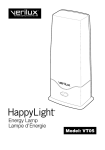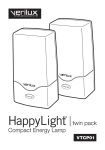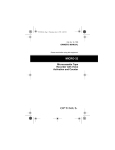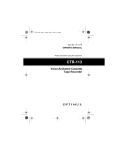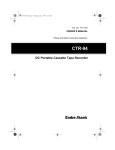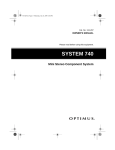Download Radio Shack TCR-200 Owner`s manual
Transcript
43-473.fm Page 1 Friday, August 13, 1999 9:21 AM Cat. No. 43-473 OWNER’S MANUAL Please read before using this equipment. TCR-200 Telephone Cassette Recorder 43-473.fm Page 2 Friday, August 13, 1999 9:21 AM FEATURES Your RadioShack TCR-200 Telephone Cassette Recorder is perfect for your home or office. It records telephone calls you make or receive and you can also use it as a tape recorder to record dictation or conversations during a meeting. Handset Adapter — lets you record conversations directly from the phone you are talking on. Earphone Jack — lets you connect an earphone with a 1/8-inch plug for private listening. It includes these features: Voice-Actuated (VOX) Recording — records only when it receives sound, to save power and prevent blank sections on the tape. Regular Recording — lets you record dictation or conversations at the touch of a button. Monitor — lets you listen to a conversation through the telephone cassette recorder’s speaker as it is being recorded. Automatic Stop — releases the tapehandling parts when the tape reaches the end while playing or recording. Built-In Microphone — lets you record without connecting an external microphone. Cue/Review Function — lets you advance or rewind the tape during play to find a specific section on the tape. Two Power Sources — let you power the telephone cassette recorder from AC power or four AA batteries. You need at least one cassette tape to use the recorder. We recommend you use a 30-minute incoming message leaderless tape (RadioShack Cat. No. 43-410) so you do not miss the beginning of a call. You also need either 4 AA batteries or an AC adapter to power the recorder. We suggest you write your recorder’s serial number here. The number is on the bottom of the recorder. Serial Number __________________ This telephone cassette recorder has been tested and found to comply with applicable UL and FCC standards. Important: It is illegal in some states to record a conversation without the consent of all parties involved in the conversation, including the phone company. Check the laws in your area before using the telephone cassette recorder. © 1997, 1998 Tandy Corporation. All Rights Reserved. RadioShack is a registered trademark used by Tandy Corporation. 2 43-473.fm Page 3 Friday, August 13, 1999 9:21 AM READ THIS BEFORE INSTALLATION Each device that you connect to the phone line draws power from the phone line. We refer to this power draw as the device’s ringer equivalence number, or REN. The REN is on the bottom of your telephone cassette recorder. If you are using more than one device on the line, add up all the RENs. If the total is more than five, your phone might not ring and your telephone cassette recorder might not record. In rural areas, a total REN of three might impair ringer operation. If ringer operation is impaired, disconnect one of the devices from the line. FCC STATEMENT Your telephone cassette recorder complies with Part 68 of FCC Rules. You must, upon request, provide the FCC registration number and the REN to your phone company. Both numbers are on the bottom of your telephone cassette recorder. Warning: To reduce the risk of fire or shock hazard, do not expose this product to rain or moisture. CAUTION RISK OF ELECTRIC SHOCK. DO NOT OPEN. ! CAUTION: TO REDUCE THE RISK OF ELECTRIC SHOCK, DO NOT REMOVE COVER OR BACK. NO USER-SERVICEABLE PARTS INSIDE. REFER SERVICING TO QUALIFIED PERSONNEL. This symbol is intended to alert you to the presence of uninsulated dangerous voltage within the product’s enclosure that might be of sufficient magnitude to constitute a risk of electric shock. Do not open the product’s case. ! This symbol is intended to inform you that important operating and maintenance instructions are included in the literature accompanying this product. Note: You must not connect your telephone cassette recorder to: • coin-operated systems • party-line systems • most electronic key phone systems 3 43-473.fm Page 4 Friday, August 13, 1999 9:21 AM CONTENTS Preparation .............................................................................................................. Connecting Power .............................................................................................. Using AC Power ........................................................................................... Using Battery Power .................................................................................... 5 5 5 5 Installation ............................................................................................................... 6 Connecting Directly to the Phone Line ............................................................... 6 Connecting to A Phone ....................................................................................... 6 Using an Earphone ............................................................................................. 7 Listening Safely ............................................................................................ 7 Operation ................................................................................................................. 8 Setting the Beep ................................................................................................. 8 Loading a Cassette Tape .................................................................................... 8 Recording a Phone Conversation ....................................................................... 8 Setting the Record Mode ............................................................................. 9 Setting the Sensitivity Level ......................................................................... 9 Setting the Recording Speed ..................................................................... 10 Listening While You Record ....................................................................... 10 Regular Recording ............................................................................................ 10 Playing a Tape .................................................................................................. 11 Fast-Forward and Rewind .......................................................................... 11 Using the Tape Counter ............................................................................. 11 Care and Maintenance .......................................................................................... Tape Tips and Techniques ................................................................................ Preventing Accidental Erasure ................................................................... Restoring Tape Tension and Sound Quality ............................................... Cleaning the Tape-Handling Parts ............................................................. The FCC Wants You to Know ........................................................................... Lightning ........................................................................................................... 4 12 13 13 13 14 14 14 43-473.fm Page 5 Friday, August 13, 1999 9:21 AM PREPARATION CONNECTING POWER Using Battery Power Using AC Power Your telephone cassette recorder can use four AA batteries (not supplied) for power. For the best performance and longest life, we recommend alkaline batteries, such as Cat. No. 23-552. Follow these steps to connect your telephone cassette recorder to AC power. Follow these steps to install batteries. CAUTION ALWAYS DISCONNEC LINES FROM THE WA SERVICING OR DISA EQUIPMENT, OR REP + + Caution: You must use a 120V AC/6V DC adapter that delivers at least 300 milliamps. Its center tip must be set to negative, and its plug must properly fit the TCR-200’s DC 6V jack. The recommended adapter meets these requirements. Using an adapter that does not meet these requirements could damage the telephone cassette recorder or the adapter. + You can power your telephone cassette recorder from AC power using an optional AC adapter, such as RadioShack Cat. No. 273-1662. + 1. Press the battery compartment cover’s tab and lift off the cover. 2. Insert the batteries into the compartment, as indicated by the polarity symbols (+ and –) marked inside the compartment. 3. Replace the cover. 1. Set the AC adapter’s voltage switch to 6V. Caution: Do not mix old and new batteries, different types of batteries (standard, alkaline, or rechargeable), or rechargeable batteries of different capacities. 2. Insert the 5.5 mm outer diameter/ 2.1 mm inner diameter barrel plug into the adapter’s cord to read TIP –. Replace the batteries when the recording indicator dims. MIC TEL EAR DC 6V 300ma OFF ON MONITOR VOX NORM REC MODE STD EXT SPEED 3. Insert the plug into the telephone cassette recorder’s DC 6V jack. 4. Plug the adapter into a standard AC outlet. 5 43-473.fm Page 6 Friday, August 13, 1999 9:21 AM INSTALLATION You can connect the telephone cassette recorder directly to the phone line or a single phone. Select a location for your telephone cassette recorder that is out of the way of normal activities. CONNECTING DIRECTLY TO THE PHONE LINE When connected to the phone line, the recorder records phone conversations on any phone on that line. Follow these steps to connect the telephone cassette recorder to the phone line. MIC TEL EAR DC 6V 300ma OFF ON MONITOR VOX NORM REC MODE STD EXT SPEED Dual-Prong Cord Dual-Prong Cord 1. Plug the supplied dual-prong cord into the recorder’s TEL jacks. 2. Insert the dual-prong cord’s modular plug into a modular phone line jack. Notes: • If the phone line jack is not a modular jack, you must update the wiring. You can convert the wiring yourself, using jacks and adapters available at your local RadioShack store, or you can let the phone company update the wiring for you. • The USOC number of the jack to be installed is RJ11C. 6 CONNECTING TO A PHONE You can use the supplied handset adapter to connect the telephone cassette recorder to the same phone you plan to talk on. When connected this way, the recorder only records the phone conversations on that phone. Important: The law in some areas requires that all parties on the phone line be able to hear a beep indicating the conversation is being recorded. If you connect the telephone cassette recorder to your phone using the supplied dualprong cord and handset adapter, all parties on the phone line might not hear a beep during recording. We recommend you check the laws in your area. If it is unlawful to record without a beep sounding, or if you are unsure, connect the telephone cassette recorder as described in “Connecting Directly to the Phone Line” to ensure the beep will sound. Note: The RadioShack Cat. No. 279357 adapter might be required for some installations. 1. Plug the supplied dual-prong cord into the recorder’s TEL jacks. 2. Insert the dual-prong cord’s modular plug and the phone’s handset cord into the handset adapter. 43-473.fm Page 7 Friday, August 13, 1999 9:21 AM Handset Cord Cord Handset MIC TEL EAR DC 6V 300mA OFF ON VOX NORM MONITOR REC MODE STD EXT SPEED Handset Adapter Adapter Handset MIC EAR DC 6V 300ma OFF ON MONITOR VOX NORM REC MODE STD EXT SPEED Dual-Prong Cord Dual-Prong Cord Note: Plug the dual-prong cord’s plug into the larger modular jack and the handset cord’s plug into the smaller jack. 3. Insert the handset adapter into the telephone’s modular handset jack. Handset Cord Cord Handset Handset Adapter EAR DC 6V 300ma OFF ON MONITOR Listening Safely To protect your hearing, follow these guidelines when you use an earphone. • Do not listen at extremely high volume levels. Extended high-volume listening can lead to permanent hearing loss. Handset Adapter MIC Note: The speaker automatically disconnects when you plug in an earphone. VOX NORM REC MODE STD EXT SPEED Dual-Prong Cord Dual-Prong Cord USING AN EARPHONE To connect an earphone (not supplied), insert the earphone’s 1/8-inch plug into the EAR jack on the back of the telephone cassette recorder. You can find a wide selection of earphones at your local RadioShack store. • Set the volume to its lowest level before you begin listening. After you put on the earphone, adjust the volume to a comfortable listening level. • Do not increase the volume once you have established a comfortable listening level. Over time, your ears adapt to the volume level, so a volume level that does not cause discomfort might still damage your hearing. 7 43-473.fm Page 8 Friday, August 13, 1999 9:21 AM OPERATION SETTING THE BEEP You can set the telephone cassette recorder to beep every 15 seconds while recording. 2. Press STOP/EJECT to open the cassette compartment door. Put the cassette in the compartment with the cassette’s open edge facing you and the full reel on the left. Note: You might be legally required to set BEEP TONE to ON when recording, so all parties know the conversation is being recorded. Check the laws in your area. VU EL LEV MIC 3. Close the door. 1. Remove the battery compartment cover and remove the batteries, if installed. 2. Set BEEP TONE to ON. The telephone cassette recorder beeps every 15 seconds while recording. ALWAYS DISCONNECT ALL TELEPHONE LINES FROM THE WALL OUTLETS BEFORE SERVICING OR DISASSEMBLING THIS EQUIPMENT, OR REPLACING BATTERIES. --- + DC 6V (UM/SUM-3) X4 + --- Notes: • You can buy cassettes of varying lengths at your local RadioShack store. • Replace the tape at least once a year, or more often if it is used heavily. BEEP TONE --- + ON + --- OFF 3. Replace the batteries and the cover. LOADING A CASSETTE TAPE Follow these steps to install a cassette tape (not supplied) in the recorder. 1. Turn the cassette’s hub with a pencil to take up any tape slack. 8 RECORDING A PHONE CONVERSATION You can record both sides of a conversation on any phone connected to the same phone line as the recorder. 1. Set REC MODE, the sensitivity level, SPEED, and MONITOR to the desired settings. (See “Setting the Record Mode” on Page 9, “Setting the Sensitivity Level” on Page 9, “Setting the Recording Speed” on Page 10, and “Listening While You Record” on Page 10.) 43-473.fm Page 9 Friday, August 13, 1999 9:21 AM 2. Press RECORD. Both RECORD and PLAY lock down. When RECORD is pressed down, every call made or received is recorded. Notes: • If you set REC MODE to VOX, when both parties are silent for about 5 seconds, the recorder stops recording until someone starts speaking again. • The VOLUME setting does not affect the recording level. • VU/LEVEL flashes during recording. MIC TCR-200 VOICE ACTIVATED TELEPHONE CASSETTE RECORDER • To temporarily stop recording, press PAUSE. To resume recording, press PAUSE again. REVIEW RECORD PLAY REWIND CUE FAST-F STOP/EJECT When REC MODE is set to VOX, the recorder begins recording when it receives sound through the microphone or phone line, and stops recording when it does not receive sound for about 5 seconds. DC 6V 300mA OFF ON VOX NORM MONITOR REC MODE STD EXT SPEED Set REC MODE to NORM to record continuously until the tape reaches the end or you press STOP/EJECT. Setting the Sensitivity Level VU LEVEL 000 Setting the Record Mode PAUSE When you set REC MODE to VOX, you must set the sensitivity level located on the bottom of the recorder. H (high) is the most sensitive setting and requires only a soft sound to begin recording. L (low) is the least sensitive setting and requires a louder sound to begin recording. If the tape does not stop after about 5 seconds of silence, set SENSITIVITY to M (medium) or L (low). SENSITIVITY LMH • If the tape reaches the end during a recording, it automatically releases RECORD and PLAY, and stops. 3. To stop recording, press STOP/ EJECT. CAUTION ALWAYS DISCONNECT ALL TELEPHONE LINES FROM THE WALL OUTLETS BEFORE SERVICING OR DISASSEMBLING THIS EQUIPMENT, OR REPLACING BATTERIES. 9 43-473.fm Page 10 Friday, August 13, 1999 9:21 AM Setting the Recording Speed REGULAR RECORDING Set SPEED to EXT (extended) to record at a slower speed and a lower quality than regular speed, but extend the recording time. Tapes recorded with SPEED set to EXT must be played back with the recorder set to EXT. You can use your telephone cassette recorder as a regular cassette recorder for recording dictation or conversations. For regular recording, be sure the dualprong cord is not plugged in. Set SPEED to STD (standard) to record at regular speed. When you record with SPEED set to STD, you can play back the tape on this recorder (with SPEED set to STD) or any other cassette tape player. DC 6V 300mA OFF ON VOX NORM MONITOR REC MODE STD OFF ON VOX NORM REC MODE STD EXT SPEED Note: While you record your own phone conversation, set MONITOR to OFF. Otherwise, it might cause a high-pitched tone to sound through your telephone handset or through the telephone cassette recorder’s speaker. 10 PLAY REWIND CUE FAST-F STOP/EJECT PAUSE EXT Set MONITOR to ON to listen to a conversation through the telephone cassette recorder’s speaker as it is being recorded. Slide VOLUME to a comfortable listening level. MONITOR REVIEW RECORD SPEED Listening While You Record DC 6V 300mA Set REC MODE to NORM for continuous recording, then press RECORD. Both RECORD and PLAY lock down. Then speak into the built-in microphone from a distance of about 12 inches. Note: To temporarily stop recording, press PAUSE . To resume recording, press PAUSE again. To stop recording, press STOP/EJECT. 43-473.fm Page 11 Friday, August 13, 1999 9:21 AM PLAYING A TAPE Note: The recorder automatically stops when it reaches the end of the tape. 1. Set SPEED to the desired tape speed (see “Setting the Recording Speed” on Page 10). 2. Press PLAY. Playback begins. Note: Press PAUSE to temporarily stop the tape while you play it. Press PAUSE again to resume play. 3. Adjust VOLUME to a comfortable listening level. 4. Press STOP/EJECT to stop play. If the cassette tape plays to the end, the cassette deck automatically releases PLAY and stops. Using the Tape Counter You can use the tape counter to mark positions on a cassette tape during recording or playback. Before you play a cassette tape, rewind the cassette tape and press the button to the right of the tape counter to set it to 000. As the cassette tape moves, the counter advances. Note the tape counter reading at the position you want to return to later. 000 Fast-Forward and Rewind REVIEW RECORD PLAY REWIND CUE FAST-F STOP/EJECT PAUSE VU LEVEL MIC TCR-200 VOICE ACTIVATED TELEPHONE CASSETTE RECORDER When the tape is stopped, press CUE/ FAST-F to wind the tape rapidly forward or REVIEW/REWIND to wind the tape rapidly backward. Press STOP/EJECT to stop the tape. During play, hold down CUE/FAST-F or REVIEW/REWIND to hear playback as the tape fast-forwards or rewinds to find desired locations on a tape quickly. When you release the button, the telephone cassette recorder returns to normal speed. 11 43-473.fm Page 12 Friday, August 13, 1999 9:21 AM CARE AND MAINTENANCE Your TCR-200 Telephone Cassette Recorder is an example of superior design and craftsmanship. The following suggestions will help you care for your telephone cassette recorder so you can enjoy it for years. Keep the telephone cassette recorder dry. If it gets wet, wipe it dry immediately. Liquids might contain minerals that can corrode the electronic circuits. Use and store the telephone cassette recorder only in normal temperature environments. Temperature extremes can shorten the life of electronic devices, damage batteries, and distort or melt plastic parts. Keep the telephone cassette recorder away from dust and dirt, which can cause premature wear of parts. Handle the telephone cassette recorder gently and carefully. Dropping it can damage circuit boards and cases and can cause the telephone cassette recorder to work improperly. Use only fresh batteries of the required size and recommended type. Batteries can leak chemicals that damage your telephone cassette recorder’s electronic parts. Wipe the telephone cassette recorder with a damp cloth occasionally to keep it looking new. Do not use harsh chemicals, cleaning solvents, or strong detergents to clean the telephone cassette recorder. Modifying or tampering with the telephone cassette recorder’s internal components can cause a malfunction and might invalidate its warranty and void your FCC authorization to operate it. If your telephone cassette recorder is not performing as it should, take it to your local RadioShack store for assistance. If the trouble is affecting the telephone lines, the phone company can ask you to disconnect your cassette recorder until you have resolved the problem. 12 43-473.fm Page 13 Friday, August 13, 1999 9:21 AM TAPE TIPS AND TECHNIQUES If you later decide to erase or record over the tape, you can place a piece of tape over the holes. The following tips can help you get the best performance and the longest life from your telephone cassette recorder. Tape Over Side A Tab Side A Tab Note: Do not use endless or C-120 cassette tapes. C-120 tape is very thin and can tangle easily. Preventing Accidental Erasure Most cassette tapes have two eraseprotection tabs — one for each side of the tape. When a tab is in place, you can erase or record on that tape side. When the tab is not in place, you cannot erase or record on that side. To prevent your recordings from being accidentally erased or recorded over, carefully break off the erase-protection tabs using a screwdriver or similar tool. Side A Side A A SideTab A Tab Side A SideB B Tab Side Tab Note: When covering the holes, cover only the portions that were originally protected by the plastic tabs. Restoring Tape Tension and Sound Quality After you play a cassette tape several times, the tape might become tightly wound on the cassette reels. This can cause playback sound quality to deteriorate. To restore the sound quality, fast-forward the tape from the beginning to the end of one side, then completely rewind it. Then loosen the tape reels by gently tapping each side of the cassette’s outer shell on a flat surface. Caution: Be careful not to damage the cassette when tapping it. Do not touch the exposed tape or allow any sharp objects near the cassette. 13 43-473.fm Page 14 Friday, August 13, 1999 9:21 AM Cleaning the Tape-Handling Parts THE FCC WANTS YOU TO KNOW Dirt, dust, or particles of the tape’s coating can accumulate on the tape heads and other parts that the tape touches. This can greatly reduce the telephone cassette recorder’s performance. Use the following cleaning procedure after about every 20 hours of operation. In the unlikely event that your telephone cassette recorder causes problems on the phone line, the phone company can disconnect your service. The phone company attempts to notify you in advance. If advance notice is not practical, the phone company notifies you of your right to file a complaint with the FCC. 1. Remove the batteries and disconnect the AC adapter. 2. Open the cassette compartment door. 3. Hold down the protection tab sensor in the tape compartment while you press RECORD to expose the tapehandling parts. 4. Use a swab dipped in tape head cleaning solution or denatured alcohol to gently clean the record/play head, pinch roller, capstan, erase head, and tape guides. Tape Guides Rubber Rubber Pinch PinchRoller Roller Capstan Capstan Cotton Swab Cotton Swab Record and Record and Erase Heads Erase Heads 5. When you finish cleaning, press STOP/EJECT and close the compartment. Your local RadioShack store carries a complete line of tape head-cleaning accessories. 14 Also, the phone company can make changes to its lines, equipment, operations, or procedures that could affect the operation of your telephone cassette recorder. The phone company notifies you of these changes in advance, so you can take steps to prevent interruption of your phone service. LIGHTNING Your telephone cassette recorder has built-in protection circuits to reduce the risk of damage from surges in phone and power line current. These protection circuits meet or exceed FCC requirements. However, lightning striking the phone line or power lines can damage your telephone cassette recorder. Lightning damage is not common. Nevertheless, if you live in an area that has frequent electrical storms, we suggest that you unplug your telephone cassette recorder during storms to reduce the possibility of damage. 43-473.fm Page 15 Friday, August 13, 1999 9:21 AM NOTES 15 43-473.fm Page 16 Friday, August 13, 1999 9:21 AM Limited One-Year Warranty This product is warranted by RadioShack against manufacturing defects in material and workmanship under normal use for one (1) year from the date of purchase from RadioShack company-owned stores and authorized RadioShack franchisees and dealers. EXCEPT AS PROVIDED HEREIN, RadioShack MAKES NO EXPRESS WARRANTIES AND ANY IMPLIED WARRANTIES, INCLUDING THOSE OF MERCHANTABILITY AND FITNESS FOR A PARTICULAR PURPOSE, ARE LIMITED IN DURATION TO THE DURATION OF THE WRITTEN LIMITED WARRANTIES CONTAINED HEREIN. EXCEPT AS PROVIDED HEREIN, RadioShack SHALL HAVE NO LIABILITY OR RESPONSIBILITY TO CUSTOMER OR ANY OTHER PERSON OR ENTITY WITH RESPECT TO ANY LIABILITY, LOSS OR DAMAGE CAUSED DIRECTLY OR INDIRECTLY BY USE OR PERFORMANCE OF THE PRODUCT OR ARISING OUT OF ANY BREACH OF THIS WARRANTY, INCLUDING, BUT NOT LIMITED TO, ANY DAMAGES RESULTING FROM INCONVENIENCE, LOSS OF TIME, DATA, PROPERTY, REVENUE, OR PROFIT OR ANY INDIRECT, SPECIAL, INCIDENTAL, OR CONSEQUENTIAL DAMAGES, EVEN IF RadioShack HAS BEEN ADVISED OF THE POSSIBILITY OF SUCH DAMAGES. Some states do not allow the limitations on how long an implied warranty lasts or the exclusion of incidental or consequential damages, so the above limitations or exclusions may not apply to you. In the event of a product defect during the warranty period, take the product and the RadioShack sales receipt as proof of purchase date to any RadioShack store. RadioShack will, at its option, unless otherwise provided by law: (a) correct the defect by product repair without charge for parts and labor; (b) replace the product with one of the same or similar design; or (c) refund the purchase price. All replaced parts and products, and products on which a refund is made, become the property of RadioShack. New or reconditioned parts and products may be used in the performance of warranty service. Repaired or replaced parts and products are warranted for the remainder of the original warranty period. You will be charged for repair or replacement of the product made after the expiration of the warranty period. This warranty does not cover: (a) damage or failure caused by or attributable to acts of God, abuse, accident, misuse, improper or abnormal usage, failure to follow instructions, improper installation or maintenance, alteration, lightning or other incidence of excess voltage or current; (b) any repairs other than those provided by a RadioShack Authorized Service Facility; (c) consumables such as fuses or batteries; (d) cosmetic damage; (e) transportation, shipping or insurance costs; or (f) costs of product removal, installation, set-up service adjustment or reinstallation. This warranty gives you specific legal rights, and you may also have other rights which vary from state to state. RadioShack Customer Relations, Dept. W, 100 Throckmorton St., Suite 600, Fort Worth, TX 76102 We Service What We Sell 3/97 RadioShack A Division of Tandy Corporation Fort Worth, Texas 76102 7A8 Printed in Hong Kong



















